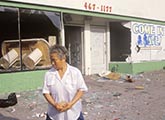What has the 1992 LA uprising/Saigu taught us about race relations between communities of color?
Saigu is the romanization of the Korean words for 4-2-9, representing the date April 29, 1992. This date marked the beginning of the Los Angeles Riot, also referred to as the L.A. uprising or the L.A. civil unrest to emphasize the political character of the public's anger as a response to racism in the criminal justice system, heavy-handed immigration enforcement, civic neglect of poor neighborhoods, and economic inequality.
When a jury ruled that four Los Angeles Police Department (LAPD) officers were not guilty in the beating of Rodney King, protests in South Los Angeles turned violent. While the LAPD protected the University of Southern California, the Financial District, and Hancock Park, business owners who called to report looting and property destruction in Pico-Union and Koreatown received no assistance from police. The majority of the $1 billion in property damage that occurred during the unrest was sustained by businesses owned by L.A.'s Korean American community. Saigu was deeply traumatic for that community, and scholars have described this shared experience of violence and loss as a formative event for the emergence of a collective sense of Korean American identity.
Media coverage leading up to and during the unrest drew attention to the "Black-Korean conflict": tensions between Korean American store owners and members of Black communities in South Central L.A. who perceived these store owners as outsiders who charged high prices for substandard goods, mistreated Black customers, and failed to invest in the communities where their businesses were located. The shooting of a Black teenager, Latasha Harlins, by a Korean American store owner, Soon Ja Du— and the light sentence Du received—contributed to the tensions leading up the uprising.
Since 1992, scholars have criticized how the media's focus on the Black-Korean conflict drew attention away from the issue of misconduct by the LAPD and racism in the court system. Tensions were attributed to cultural misunderstandings, without attention to how the specific histories of anti-Blackness and anti-Asian racism gave rise to these tensions or the underlying context of racial and economic inequality. Thus, the media narrative of Black-Korean conflict was one that avoided implicating white political and economic elites in the injustices that led to the uprising.
The uprising led some members of L.A.'s Korean American community to seek greater political participation and empowerment and inspired further efforts toward interracial understanding and coalition-building. According to Edward Park, despite a short-term white conservative backlash, in the long-term, interracial coalition-building in response to the unrest led to the eventual incorporation of Latinos and Asian Americans into the city's multiracial power structure.
Carol K. Park's essay describes how the media narrative of the "Black-Korean conflict" scapegoated Korean Americans. Saigu, she says, teaches the need for dialogue and communication between ethnic groups in order to identify and address the root causes of social problems.
Stephen Suh, on the other hand, argues that while scholarly critiques of the media coverage of the Black-Korean conflict are well-grounded, this does not negate the existence of conflicting interests and real tensions. While building solidarity between communities of color is necessary, the difficulties should not be minimized; instead, "what needs to be emphasized is not only an effort to mobilize through group differences and not in spite of them." Suh argues that activists should recognize that, while tensions and conflict are inevitable in coalition-building, this does not negate the possibility of effecting social change.
MLA Citation
Suh, Stephen Cho. "What Has the 1992 LA Uprising/Saigu Taught Us about Race Relations between Communities of Color?" The American Mosaic: The Asian American Experience, ABC-CLIO, 2025, asianamerican2.abc-clio.com/Search/Display/2338816. Accessed 23 Apr. 2025.



